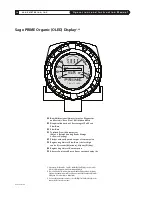
S A G E M E T E R I N G , I N C .
O p e r a t i o n s a n d I n s t r u c t i o n M a n u a l
44
REV. 16-SIP/SRP
e) An Ohm Meter is required to check across the sen-
sor leads of the Flow Sensor. Look at the drawing
of the Junction Box. Disconnect the red wires on
the Factory Side to isolate and measure the resist-
ance. If the reading is infinity or a short, it means
that sensor has failed.
f) Now check the Temperature Sensor. Disconnect the
white wires on the Factory Side to isolate and meas-
ure the resistance. If you have infinity or a short, it
means that sensor is burned out.
Note:
Normally the
sensors will read approximately 110 ohms at 70˚ F. At
higher temperatures they should read a higher resist-
ance, but both sensors should have a similar value.
g) On integral style meters (SIP), there is no Junction
Box. In that case, refer to the Prime Integral
Terminals on page 19 and check the sensor wires.
Remove the appro priate wires first (red pair for
flow, then white pair for temperature). Measure
their resistance. If reading infinity or short, it
means that sensor has failed.
SYMPTOM:
Meter Railing (Pegging) or Reading High
POSSIBLE CAUSES/SUGGESTED CORRECTIVE ACTION:
a) Insufficient straight run (i.e. flow profile is dis-
turbed, causing errors).
b) Possible jet effect if upstream pipe is smaller than
meter flow body or if valve is too close upstream
to meter.
c) Not following Probe Insertion Guideline.
d) If sensor is inserted in reverse (“Upstream” mark
is facing downstream) Meter may over-report (or
under-report) by as much as 30%.
e)
If sensor is not aligned properly, with “Upstream”
mark facing upstream, a rotation greater than
± 5 degrees may cause change in reading
(greater than ± 5 degrees and less than ± 20
degrees causes meter to over-report; a greater
rotation actually blocks the sensor, and causes
meter to under-report).
f) A downstream valve too close to the meter (flow
may be reflecting back).
g) Possibly caused by water droplets condensing out
of gas stream (which generally causes output to
spike; but if droplets are near continuous, output
may rail).
h) Meter is miswired, especially in Remote Style
application.
i)
Possibly caused by water droplets condensing on
inside of pipe wall, which roll down or hit sensor
causing output to spike; but if droplets are near
continuous, output may rail.
Note:
Recommend in -
stallation 45˚ from vertical (see drawing on page 68).
j)
Possibly caused by water droplets condensing out
of gas stream and filling the cavity containing the
sensing elements (usually due to probes mounted
below horizontal in saturated pipes).
k) Sensor may be contaminated. Remove probe,
wipe off or clean with a solvent. Reinsert.
l)
Using a different gas or gas mix than the meter
was specified and calibrated for.
m) If a Remote Style Meter (SRP), be sure Serial
Numbers of Junction Box and Remote Electronics
are identical (if not, errors in calibration are in -
evi table). To confirm, verify that Junction Box
Serial Number Tag has identical Serial Numbers
to Tag on Remote Enclosure.
n) Meter may appear to be reading high if user is
comparing Sage flow meter readings (SCFM) to
an uncorrected volumetric device (ACFM). For
example, at constant volume, a decrease in gas
temperature will increase the mass flow (SCFM).
That is completely normal.
SYMPTOM:
Reading Low
POSSIBLE CAUSES:
a)
Insufficient straight run (i.e. flow profile is
disturbed, causing errors).
b) Poor flow profile Upstream (insufficient upstream
straight run).
c)
Not following Probe Insertion Guideline.
d) If sensor is inserted in reverse (“Upstream” mark
is facing downstream) Meter may over-report (or
under-report) by as much as 30%.
e) If sensor is not aligned properly, with “Upstream”
mark facing upstream, a rotation greater than ± 5
degrees may cause change in reading (greater than
± 5 degrees and less than ± 20 degrees causes meter
to over-report; a greater rotation actually blocks
the sensor, and causes meter to under-report).
Summary of Contents for SIP
Page 2: ......
Page 6: ......
Page 7: ...Section GETTING STARTED A...
Page 8: ......
Page 25: ...Section STYLES AND FEATURES B...
Page 26: ......
Page 32: ......
Page 33: ...Section DRAWINGS C...
Page 34: ......
Page 41: ...Section DIAGNOSTICS D...
Page 42: ......
Page 47: ...Section WARRANTIES AND SERVICE WORK E...
Page 48: ......
Page 53: ...Section MODBUS F...
Page 54: ......
Page 63: ...G Section APPENDIX G...
Page 64: ......
















































